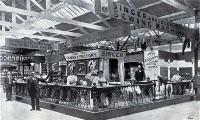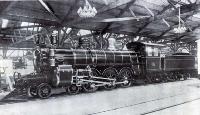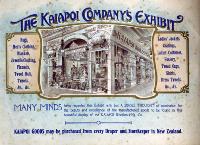The Trade and Commercial Courts
- The Trade and Commercial Courts at the Exhibition served as elaborate "shop windows" of goods and products manufactured in New Zealand as well as Britain, Australia, and Canada.
- Many displays were as much an artistic endeavour as a commercial one.
- The kinds of products on display ranged across many different industries and included foods, furniture, machinery, clothing and much more.
Buy New Zealand made
The Press noted that "the private exhibits still remain a most important part of an industrial fair"1, and added that those at the Exhibition were numerous, varied, and often elaborate and artistic. It could fairly be said that "Trade lay behind almost everything at Hagley Park".2 The Premier, Joseph Ward, in a speech at the banquet celebrating the Exhibition opening, expressed the hope that the Exhibition would show the world "what New Zealand could produce in the way of livestock, grain and minerals; and also that it produced first-class boys and girls who were in no inconsiderable portion of the asset it possessed".3 Both the government and especially the provincial courts presented themselves "largely through the products of their farms, public enterprises and private industries"4, while foreign exhibitors also featured their agricultural, mineralogical and industrial outputs.
Products
The commercial courts were organised according to type: textiles (mostly wool), clothing, boots, shoes and leatherwork, food, alcoholic beverages, tobacco, agricultural machinery, engineering, furniture, art, pottery, fancy goods, jewellery, maritime services, musical instruments, photography, printing and miscellaneous.
Industries
Among the major exhibitors were freezing works, woollen mills, sheep breeders, department stores and other retailers, factories, agricultural machinery manufacturers, iron founders and engineering firms, furniture makers and interior decorators, printers (including The Press, The Lyttelton Times and the Government Printer), and shipping companies.
Food and Drink
There were displays from 16 large breweries, 27 wine and spirits firms and over 20 cordial and aerated waters manufacturers. Two women and one man exhibited home-made wines. Foodstuffs included confectionary, biscuits, canned meat and fish, sauces and other condiments, honey, tea and coffee, spices, dairy products, cereals and preserved fruit.
Fancy Goods and other essentials
Among the items on display was the "finest collection of porcelain ever seen in Australasia" (Press)5, comprised of Royal Doulton, Wedgwood and Royal Worcester exhibits, while the jewellery section featured "truly magnificent"6 opals from Queensland. Every kind of musical instrument was displayed, both foreign- and New Zealand-made, along with sheet music, records, phonograms and gramophones. The maritime section contained models of steamships, coastal vessels and harbour works. The miscellaneous section covered a wide range of goods from soaps and perfumery to artificial limbs and surgical appliances. A number of stalls sold greenstone mementoes, including "grotesque little tikis"7, mostly of European manufacture. Only two stalls were run by Māori and these featured excellent specimens of carving and replicas of Māori weapons, as well as beautiful woven goods.
![]()
Related photos
 A view of the Singer Manufacturing Company's exhibit opposite the British Court |
 A new engine exhibited by the Addington Workshops |
 The Kaiapoi Company's exhibit |
Sources
- Cowan, J. Official record of the New Zealand International Exhibition of Arts and Industries held at Christchurch, 1906-7, page 286-307
- Mclean, G. "The Colony commodified: Trade, progress and the real business of exhibitions". In J.M. Thomson (Ed.), Farewell colonialism : the New Zealand International Exhibition, Christchurch, 1906-07, page 27-38
- "The private exhibits", The Press, 2 November 1906, page 12
Related links
Footnotes
- [1] "The private exhibits", The Press, 2 November 1906, page 12
- [2] Mclean, G. "The Colony commodified: Trade, progress and the real business of exhibitions". In Farewell colonialism, page 33
- [3] Cowan, J. Official record, page 96
- [4] Mclean, G. "The Colony commodified: Trade, progress and the real business of exhibitions". In Farewell colonialism, page 33
- [5] "The private exhibits", The Press, 2 November 1906, page 12
- [6] Cowan, J. Cowan, J. Official record, page 300
- [7] Cowan, J. Cowan, J. Official record, page 307




